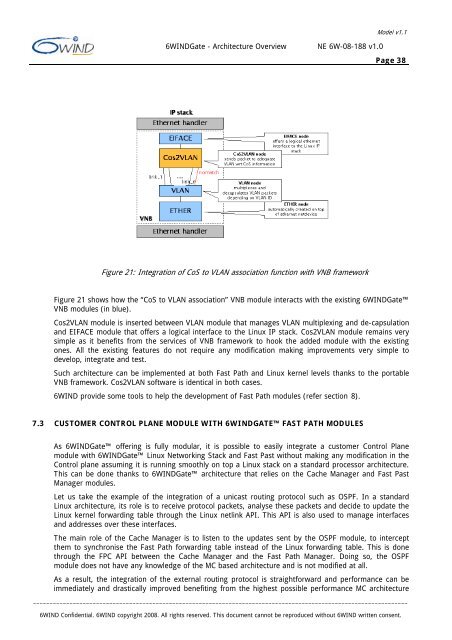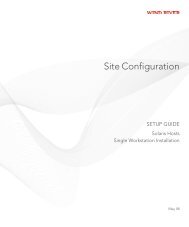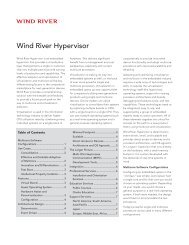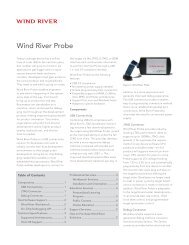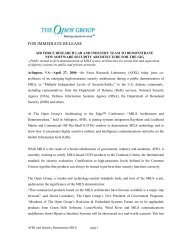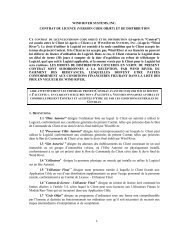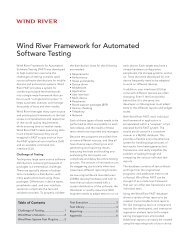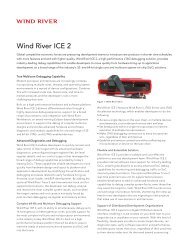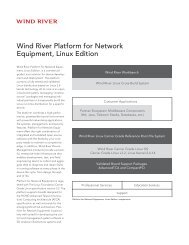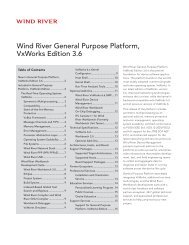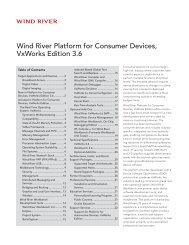6WINDGate™ - Architecture Overview - NE 6W-08-188 ... - Wind River
6WINDGate™ - Architecture Overview - NE 6W-08-188 ... - Wind River
6WINDGate™ - Architecture Overview - NE 6W-08-188 ... - Wind River
You also want an ePaper? Increase the reach of your titles
YUMPU automatically turns print PDFs into web optimized ePapers that Google loves.
<strong>6W</strong>INDGate - <strong>Architecture</strong> <strong>Overview</strong> <strong>NE</strong> <strong>6W</strong>-<strong>08</strong>-<strong>188</strong> v1.0<br />
Figure 21: Integration of CoS to VLAN association function with VNB framework<br />
Model v1.1<br />
Page 38<br />
Figure 21 shows how the “CoS to VLAN association” VNB module interacts with the existing <strong>6W</strong>INDGate<br />
VNB modules (in blue).<br />
Cos2VLAN module is inserted between VLAN module that manages VLAN multiplexing and de-capsulation<br />
and EIFACE module that offers a logical interface to the Linux IP stack. Cos2VLAN module remains very<br />
simple as it benefits from the services of VNB framework to hook the added module with the existing<br />
ones. All the existing features do not require any modification making improvements very simple to<br />
develop, integrate and test.<br />
Such architecture can be implemented at both Fast Path and Linux kernel levels thanks to the portable<br />
VNB framework. Cos2VLAN software is identical in both cases.<br />
<strong>6W</strong>IND provide some tools to help the development of Fast Path modules (refer section 8).<br />
7.3 CUSTOMER CONTROL PLA<strong>NE</strong> MODULE WITH <strong>6W</strong>INDGATE FAST PATH MODULES<br />
As <strong>6W</strong>INDGate offering is fully modular, it is possible to easily integrate a customer Control Plane<br />
module with <strong>6W</strong>INDGate Linux Networking Stack and Fast Past without making any modification in the<br />
Control plane assuming it is running smoothly on top a Linux stack on a standard processor architecture.<br />
This can be done thanks to <strong>6W</strong>INDGate architecture that relies on the Cache Manager and Fast Past<br />
Manager modules.<br />
Let us take the example of the integration of a unicast routing protocol such as OSPF. In a standard<br />
Linux architecture, its role is to receive protocol packets, analyse these packets and decide to update the<br />
Linux kernel forwarding table through the Linux netlink API. This API is also used to manage interfaces<br />
and addresses over these interfaces.<br />
The main role of the Cache Manager is to listen to the updates sent by the OSPF module, to intercept<br />
them to synchronise the Fast Path forwarding table instead of the Linux forwarding table. This is done<br />
through the FPC API between the Cache Manager and the Fast Path Manager. Doing so, the OSPF<br />
module does not have any knowledge of the MC based architecture and is not modified at all.<br />
As a result, the integration of the external routing protocol is straightforward and performance can be<br />
immediately and drastically improved benefiting from the highest possible performance MC architecture<br />
_________________________________________________________________________________________________________________<br />
<strong>6W</strong>IND Confidential. <strong>6W</strong>IND copyright 20<strong>08</strong>. All rights reserved. This document cannot be reproduced without <strong>6W</strong>IND written consent.


